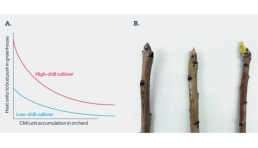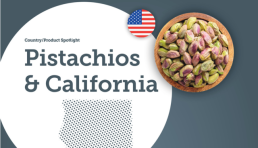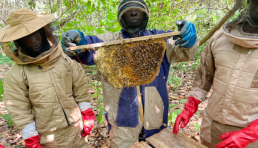Health News
Lorem ipsum
3 September 2024|
Increasing Climate Resilience of California Pistachios

To stimulate and facilitate sustainable growth in the global Nut and Dried Fruit Industry.
Ivan Bermudez, Graduate Student, Department of Plant Sciences, University of California, Davis
Dr. Paula Guzmán-Delgado, Project Scientist, Department of Plant Sciences, University of California, Davis
Prof. Giulia Marino, Associate Professor of Extension, Department of Plant Sciences, University of California, Davis
Prof. Pat J. Brown, Associate Professor, Department of Plant Sciences, University of California, Davis
Prof. Louise Ferguson, Distinguished Professor of Extension, Department of Plant Sciences, University of California, Davis
The pistachio industry in California is thriving; prices are competitive with other tree nuts, and many new orchards are being planted. However, as a dioecious tree with a high chill requirement that is widely planted across many critically overdrafted basins in California, pistachio is also vulnerable to climate change, particularly declining winter chill and reductions in water quality and quantity.
Declining Winter Chill
Pistachio, like other deciduous trees, requires exposure to prolonged periods of cold temperatures during the winter to break out of dormancy in a timely manner during the spring. In the absence of sufficient winter chill, pistachio trees exhibit delayed and non-uniform bud break, along with weak and asynchronous bloom between female cultivars and male pollinizer varieties.1 The winter of 2014-2015 had the highest average monthly temperatures in 121 years of record, and the California pistachio industry saw a 50% decrease in yield per bearing acre from the previous year.2 Unfortunately, these mild winters are only predicted to become more common in California. Marginal chill hours were observed again this winter (2023-2024), and we’ll soon know the extent to which pistachio yields have been impacted.
Preparing for future mild winters will require both improved management in the short term and improved genetics in the long term. To improve management, we need to better understand and predict how changing weather patterns affect pistachio dormancy. We can obtain useful data by collecting sticks from dormant pistachio trees throughout the winter and placing them in a warm greenhouse environment to simulate spring heat. Sticks collected later in the winter have accumulated more chill and push their buds more quickly (Figure 1). Meteorological data from each orchard are used to assign chill units, and greenhouse temperatures are used to assign heat units to each stick based on how long they took to push in the greenhouse. More predictive models will improve selection of male pollenizers during orchard establishment and improve timing of dormancy-breaking agents in established orchards. In the long term, more low-chill pistachio cultivars are needed. Golden Hills has a lower chill requirement than Kerman, and the chill requirement of Gumdrop is lower still. But as Kerman becomes more unreliable in a lower-chill future, we’ll need another low-chill variety to fill this harvest window.
 Figure 1. A) Relationship between accumulated chill and heat units to bud push. B) Examples of a dormant stick (left) and sticks with buds pushing (middle and right).
Reduced Water Quality
An additional result of climate change is the effect on water availability and quality. Higher temperatures decrease snow melt for dams and decrease precipitation for groundwater recharge. In ancient seabeds like the lower west side of the San Joaquin Valley, where soil salts are already high, groundwater salinity is further increased due to drought and fertigation. Currently, over 60% of California’s pistachio production is on moderately (4 dS/m) to extremely saline (16 dS/m) ground.
Previous studies by Ferguson et al.,3 Sanden et al.4,5 and Marino et al.6 have shown that pistachios can be grown profitably if soil electrical conductivity (ECe) is maintained at approximately 4.5–6 dS/m. The widely studied approach for controlling salt buildup involves applying 1 to 2 acre-feet of good-quality water for winter leaching by flooding or sprinkler systems. However, the availability of high-quality surface water from canals is diminishing due to persistent drought and increasing demand. As a result, growers are relying on saline pumped groundwater for in-season irrigation and winter leaching, particularly in the lower west side of the San Joaquin Valley. When saline irrigation water is used, having real-time information about both the soil’s available water content (AWC) and the soil salinity profile (ECe) would be very helpful.
Recently, advanced monitoring technologies with in-dwelling multiple capacitance sensors that continuously monitor real-time soil AWC and salinity (ECe) levels have become available. Monitoring the salinity profile in real time could significantly enhance the ability to manage irrigation to facilitate in-season leaching. The efficacy of using large-volume sprinklers or flood leaching during dormancy is well documented. However, the existing calculations for leaching requirements were developed based on one-dimensional 100% surface wetting, and there has not been a comprehensive investigation into the efficacy of single and double drip lines in managing root zone salinity through in-season leaching fractions and small-volume in-row pulsed dormant leaching.
Collectively, after two seasons, the results thus far indicate that the combination of a double irrigation line and in-season leaching have the best potential for controlling salinity in the wetted rootzone. The results also demonstrated that real-time soil monitoring using in-dwelling soil probes is useful for understanding soil water and ion movement in different soil profiles.
Reduced Water Quantity
The pistachio industry faces unprecedented challenges due to water scarcity driven by recurring droughts and environmental regulations. Current irrigation recommendations, designed to maximize tree hydration, are no longer sustainable, prompting the need for new protocols and tools that enhance profitability with reduced water use.
Fortunately, pistachios are xerophytes, a term deriving from the Greek xeros for “dry” and phytón for “plant,” highlighting the species’ high tolerance to drought. Previous studies demonstrated that reducing water application during pit hardening (June) does not impact productivity and improves split percentage at harvest, but also increases early split and, thus, nut susceptibility to contamination.7
These studies, performed on the cultivar Kerman planted on PG1 rootstocks, need a follow-up to consider current industry conditions. Golden Hills has become the most planted cultivar, UCB-1 is the most popular rootstock, pistachio has expanded in new areas of California, and new technologies for irrigation management are available. Additionally, the lack of plant-based water stress indicators for pistachio complicates water management decisions.
Our research team at UC Davis is investigating the effects of reduced irrigation applications on Golden Hills yield and yield quality. We are working on defining reliable and easy-to-measure pistachio-specific water status indicators through the integrated use of traditional and newer measurement techniques. Our first-year preliminary results suggest that significant water reduction in spring (until mid-June) and moderate reduction throughout the season can improve nut split percentages and reduce insect damage. However, due to the unusually wet conditions of the previous season, results must be interpreted cautiously. We will expand this study for several years, which will enable us to draw robust conclusions to define irrigation management guidelines under reduced water availability.
References
Figure 1. A) Relationship between accumulated chill and heat units to bud push. B) Examples of a dormant stick (left) and sticks with buds pushing (middle and right).
Reduced Water Quality
An additional result of climate change is the effect on water availability and quality. Higher temperatures decrease snow melt for dams and decrease precipitation for groundwater recharge. In ancient seabeds like the lower west side of the San Joaquin Valley, where soil salts are already high, groundwater salinity is further increased due to drought and fertigation. Currently, over 60% of California’s pistachio production is on moderately (4 dS/m) to extremely saline (16 dS/m) ground.
Previous studies by Ferguson et al.,3 Sanden et al.4,5 and Marino et al.6 have shown that pistachios can be grown profitably if soil electrical conductivity (ECe) is maintained at approximately 4.5–6 dS/m. The widely studied approach for controlling salt buildup involves applying 1 to 2 acre-feet of good-quality water for winter leaching by flooding or sprinkler systems. However, the availability of high-quality surface water from canals is diminishing due to persistent drought and increasing demand. As a result, growers are relying on saline pumped groundwater for in-season irrigation and winter leaching, particularly in the lower west side of the San Joaquin Valley. When saline irrigation water is used, having real-time information about both the soil’s available water content (AWC) and the soil salinity profile (ECe) would be very helpful.
Recently, advanced monitoring technologies with in-dwelling multiple capacitance sensors that continuously monitor real-time soil AWC and salinity (ECe) levels have become available. Monitoring the salinity profile in real time could significantly enhance the ability to manage irrigation to facilitate in-season leaching. The efficacy of using large-volume sprinklers or flood leaching during dormancy is well documented. However, the existing calculations for leaching requirements were developed based on one-dimensional 100% surface wetting, and there has not been a comprehensive investigation into the efficacy of single and double drip lines in managing root zone salinity through in-season leaching fractions and small-volume in-row pulsed dormant leaching.
Collectively, after two seasons, the results thus far indicate that the combination of a double irrigation line and in-season leaching have the best potential for controlling salinity in the wetted rootzone. The results also demonstrated that real-time soil monitoring using in-dwelling soil probes is useful for understanding soil water and ion movement in different soil profiles.
Reduced Water Quantity
The pistachio industry faces unprecedented challenges due to water scarcity driven by recurring droughts and environmental regulations. Current irrigation recommendations, designed to maximize tree hydration, are no longer sustainable, prompting the need for new protocols and tools that enhance profitability with reduced water use.
Fortunately, pistachios are xerophytes, a term deriving from the Greek xeros for “dry” and phytón for “plant,” highlighting the species’ high tolerance to drought. Previous studies demonstrated that reducing water application during pit hardening (June) does not impact productivity and improves split percentage at harvest, but also increases early split and, thus, nut susceptibility to contamination.7
These studies, performed on the cultivar Kerman planted on PG1 rootstocks, need a follow-up to consider current industry conditions. Golden Hills has become the most planted cultivar, UCB-1 is the most popular rootstock, pistachio has expanded in new areas of California, and new technologies for irrigation management are available. Additionally, the lack of plant-based water stress indicators for pistachio complicates water management decisions.
Our research team at UC Davis is investigating the effects of reduced irrigation applications on Golden Hills yield and yield quality. We are working on defining reliable and easy-to-measure pistachio-specific water status indicators through the integrated use of traditional and newer measurement techniques. Our first-year preliminary results suggest that significant water reduction in spring (until mid-June) and moderate reduction throughout the season can improve nut split percentages and reduce insect damage. However, due to the unusually wet conditions of the previous season, results must be interpreted cautiously. We will expand this study for several years, which will enable us to draw robust conclusions to define irrigation management guidelines under reduced water availability.
References
 Figure 1. A) Relationship between accumulated chill and heat units to bud push. B) Examples of a dormant stick (left) and sticks with buds pushing (middle and right).
Reduced Water Quality
An additional result of climate change is the effect on water availability and quality. Higher temperatures decrease snow melt for dams and decrease precipitation for groundwater recharge. In ancient seabeds like the lower west side of the San Joaquin Valley, where soil salts are already high, groundwater salinity is further increased due to drought and fertigation. Currently, over 60% of California’s pistachio production is on moderately (4 dS/m) to extremely saline (16 dS/m) ground.
Previous studies by Ferguson et al.,3 Sanden et al.4,5 and Marino et al.6 have shown that pistachios can be grown profitably if soil electrical conductivity (ECe) is maintained at approximately 4.5–6 dS/m. The widely studied approach for controlling salt buildup involves applying 1 to 2 acre-feet of good-quality water for winter leaching by flooding or sprinkler systems. However, the availability of high-quality surface water from canals is diminishing due to persistent drought and increasing demand. As a result, growers are relying on saline pumped groundwater for in-season irrigation and winter leaching, particularly in the lower west side of the San Joaquin Valley. When saline irrigation water is used, having real-time information about both the soil’s available water content (AWC) and the soil salinity profile (ECe) would be very helpful.
Recently, advanced monitoring technologies with in-dwelling multiple capacitance sensors that continuously monitor real-time soil AWC and salinity (ECe) levels have become available. Monitoring the salinity profile in real time could significantly enhance the ability to manage irrigation to facilitate in-season leaching. The efficacy of using large-volume sprinklers or flood leaching during dormancy is well documented. However, the existing calculations for leaching requirements were developed based on one-dimensional 100% surface wetting, and there has not been a comprehensive investigation into the efficacy of single and double drip lines in managing root zone salinity through in-season leaching fractions and small-volume in-row pulsed dormant leaching.
Collectively, after two seasons, the results thus far indicate that the combination of a double irrigation line and in-season leaching have the best potential for controlling salinity in the wetted rootzone. The results also demonstrated that real-time soil monitoring using in-dwelling soil probes is useful for understanding soil water and ion movement in different soil profiles.
Reduced Water Quantity
The pistachio industry faces unprecedented challenges due to water scarcity driven by recurring droughts and environmental regulations. Current irrigation recommendations, designed to maximize tree hydration, are no longer sustainable, prompting the need for new protocols and tools that enhance profitability with reduced water use.
Fortunately, pistachios are xerophytes, a term deriving from the Greek xeros for “dry” and phytón for “plant,” highlighting the species’ high tolerance to drought. Previous studies demonstrated that reducing water application during pit hardening (June) does not impact productivity and improves split percentage at harvest, but also increases early split and, thus, nut susceptibility to contamination.7
These studies, performed on the cultivar Kerman planted on PG1 rootstocks, need a follow-up to consider current industry conditions. Golden Hills has become the most planted cultivar, UCB-1 is the most popular rootstock, pistachio has expanded in new areas of California, and new technologies for irrigation management are available. Additionally, the lack of plant-based water stress indicators for pistachio complicates water management decisions.
Our research team at UC Davis is investigating the effects of reduced irrigation applications on Golden Hills yield and yield quality. We are working on defining reliable and easy-to-measure pistachio-specific water status indicators through the integrated use of traditional and newer measurement techniques. Our first-year preliminary results suggest that significant water reduction in spring (until mid-June) and moderate reduction throughout the season can improve nut split percentages and reduce insect damage. However, due to the unusually wet conditions of the previous season, results must be interpreted cautiously. We will expand this study for several years, which will enable us to draw robust conclusions to define irrigation management guidelines under reduced water availability.
References
Figure 1. A) Relationship between accumulated chill and heat units to bud push. B) Examples of a dormant stick (left) and sticks with buds pushing (middle and right).
Reduced Water Quality
An additional result of climate change is the effect on water availability and quality. Higher temperatures decrease snow melt for dams and decrease precipitation for groundwater recharge. In ancient seabeds like the lower west side of the San Joaquin Valley, where soil salts are already high, groundwater salinity is further increased due to drought and fertigation. Currently, over 60% of California’s pistachio production is on moderately (4 dS/m) to extremely saline (16 dS/m) ground.
Previous studies by Ferguson et al.,3 Sanden et al.4,5 and Marino et al.6 have shown that pistachios can be grown profitably if soil electrical conductivity (ECe) is maintained at approximately 4.5–6 dS/m. The widely studied approach for controlling salt buildup involves applying 1 to 2 acre-feet of good-quality water for winter leaching by flooding or sprinkler systems. However, the availability of high-quality surface water from canals is diminishing due to persistent drought and increasing demand. As a result, growers are relying on saline pumped groundwater for in-season irrigation and winter leaching, particularly in the lower west side of the San Joaquin Valley. When saline irrigation water is used, having real-time information about both the soil’s available water content (AWC) and the soil salinity profile (ECe) would be very helpful.
Recently, advanced monitoring technologies with in-dwelling multiple capacitance sensors that continuously monitor real-time soil AWC and salinity (ECe) levels have become available. Monitoring the salinity profile in real time could significantly enhance the ability to manage irrigation to facilitate in-season leaching. The efficacy of using large-volume sprinklers or flood leaching during dormancy is well documented. However, the existing calculations for leaching requirements were developed based on one-dimensional 100% surface wetting, and there has not been a comprehensive investigation into the efficacy of single and double drip lines in managing root zone salinity through in-season leaching fractions and small-volume in-row pulsed dormant leaching.
Collectively, after two seasons, the results thus far indicate that the combination of a double irrigation line and in-season leaching have the best potential for controlling salinity in the wetted rootzone. The results also demonstrated that real-time soil monitoring using in-dwelling soil probes is useful for understanding soil water and ion movement in different soil profiles.
Reduced Water Quantity
The pistachio industry faces unprecedented challenges due to water scarcity driven by recurring droughts and environmental regulations. Current irrigation recommendations, designed to maximize tree hydration, are no longer sustainable, prompting the need for new protocols and tools that enhance profitability with reduced water use.
Fortunately, pistachios are xerophytes, a term deriving from the Greek xeros for “dry” and phytón for “plant,” highlighting the species’ high tolerance to drought. Previous studies demonstrated that reducing water application during pit hardening (June) does not impact productivity and improves split percentage at harvest, but also increases early split and, thus, nut susceptibility to contamination.7
These studies, performed on the cultivar Kerman planted on PG1 rootstocks, need a follow-up to consider current industry conditions. Golden Hills has become the most planted cultivar, UCB-1 is the most popular rootstock, pistachio has expanded in new areas of California, and new technologies for irrigation management are available. Additionally, the lack of plant-based water stress indicators for pistachio complicates water management decisions.
Our research team at UC Davis is investigating the effects of reduced irrigation applications on Golden Hills yield and yield quality. We are working on defining reliable and easy-to-measure pistachio-specific water status indicators through the integrated use of traditional and newer measurement techniques. Our first-year preliminary results suggest that significant water reduction in spring (until mid-June) and moderate reduction throughout the season can improve nut split percentages and reduce insect damage. However, due to the unusually wet conditions of the previous season, results must be interpreted cautiously. We will expand this study for several years, which will enable us to draw robust conclusions to define irrigation management guidelines under reduced water availability.
References
- Crane, J. C., & Takeda, F. (1979). The Unique Response of the Pistachio Tree to Inadequate Winter Chilling1. HortScience, 14(2), 135–137. https://doi.org/10.21273/HORTSCI.14.2.135.
- Agricultural Statistics Review 2015-2016. (n.d.).
- Ferguson, L., Poss, J. A., Grattan, S. R., Grieve, C. M., Wang, D.., Wilson, C., ... & Chao, C. T. (2002). Pistachio rootstocks influence scion growth and ion relations under salinity and boron stress. Journal of the American Society for Horticultural Science, 127(2), 194-199. https://doi.org/10.21273/JASHS.127.2.194.
- Sanden, B. L., Ferguson, L., Reyes, H. C., & Grattan, S. R. (2004). Effect of salinity on evapotranspiration and yield of San Joaquin Valley pistachios. Acta Horticulturae. http://doi.org/10.17660/ActaHortic.2004.664.73.
- Sanden, B. L., Ferguson, L., & Corwin, D. L. (2014). Development and long-term salt tolerance of pistachios from planting to maturity using saline groundwater. Acta Horticulturae, (1028), 327-332. https://doi.org/10.17660/ActaHortic.2014.1028.53.
- Marino, G., Zaccaria, D., Snyder, R. L., Lagos, O., Lampinen, B. D., Ferguson, L., ... & Sanden, B. L. (2019). Actual evapotranspiration and tree performance of mature micro-irrigated pistachio orchards grown on saline-sodic soils in the San Joaquin Valley of California. Agriculture, 9(4), 76. https://doi.org/10.3390/agriculture9040076.
- Goldhamer, D. and Beede, R., 2004. Regulated deficit irrigation effects on yield, nut quality and water-use efficiency of mature pistachio trees. The Journal of Horticultural Science and Biotechnology, 79(4), pp. 538-545.
Access denied


